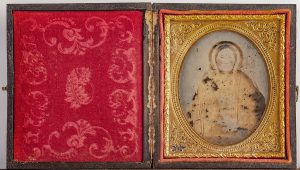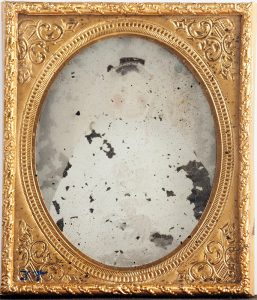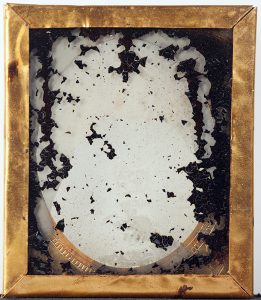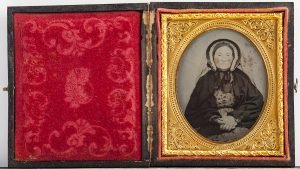A New Life After 150 Years

by Dale Wilson
If a picture is worth a thousand words, what happens when you can’t see the picture?
Such was the case recently when an ambrotype made its way to the Carriage House Studio. Even the most casual observer could see there was once a beautiful portrait on the glass plate, but time had not provided any favours.
Consideration had to be given to keep the plate as it was, or, restore it in order to see the original portrait. The decision was made to restore the plate in order to use as an educational piece, but to photograph the before and after for future reference and education.
Examination of the photograph in the case indicates the black backing had been flaking and disengaging from the negative. At this point it should be recognized that an ambrotype is simply a photographic negative lacking in density. When one places a black backing behind the negative, the image becomes a black and white positive.
As you can observe in the before photo, it is quite possible to see through the negative and view the wood grain of the case. To inspect the backing the case has to first be dismantled. This is done without using a sharp object to pry behind the glass, so doing could potentially break the glass or the incredibly thin brass plated tin.
With the picture dismantled it was quite easy to remove several flakes of the blacking to conduct a test with denatured alcohol. The denatured alcohol will render the asphaltum to a liquid tar like substance.
It is also critically important to determine if the asphaltum has been applied directly to the collodion. If this is the case, any attempt to remove the black asphaltum will also remove the collodion, and ultimately the silver image.
With this ambrotype, thankfully, the photographer opted to apply the asphultum to the glass side opposite of the collodion. Using cotton swabs and very light applications of denatured alcohol I was able to remove all of the original asphaltum. Following this, the cleaned glass was polished with a recipe that had calcium carbonate as the primary ingredient. Once polished, the glass appeared just as it did around 1863 when the portrait was made.
All that remained was to place a new piece of black backing behind the negative. Traditionally the blacking would have been asphaltum or black velvet fabric; however, I opted for black trophy aluminum as it is more stable than the older methods.
Once the glass, matte and liner have been carefully reassembled it is “snapped” back into the case to be enjoyed for another 150 years.
Sidebar: Should you have no experience working with glass plate photographs it is recommended you not attempt, there are simply too many opportunities to damage the original photograph beyond repair. Under no circumstances should a daguerreotype be cleaned, or the case even opened as they are in a sealed environment and when that seal is broken the image is lost. Should you have an ambrotype or daguerreotype that you think should be repaired, please make arrangements with the Museum and we can make recommendations at that time.




